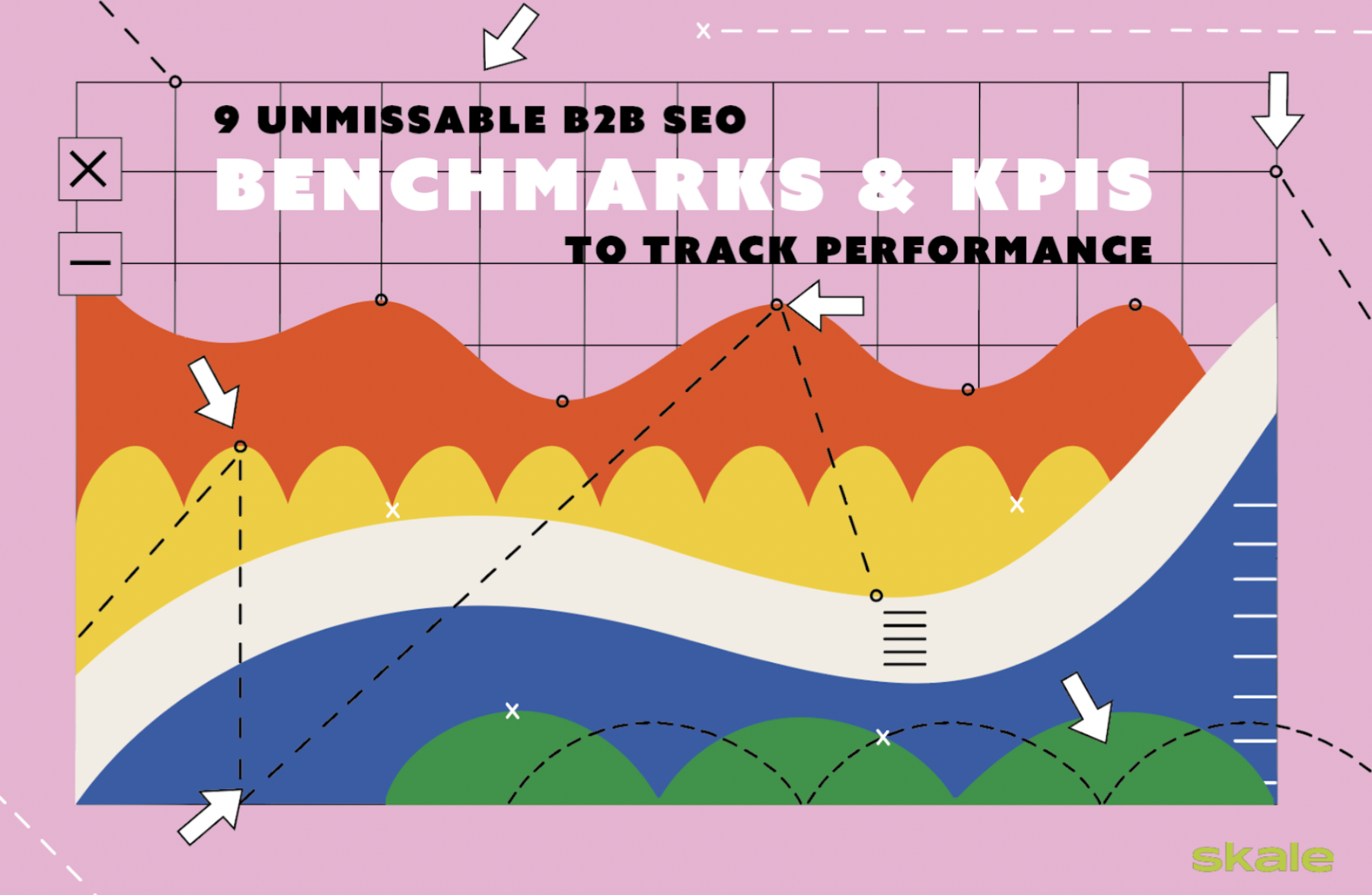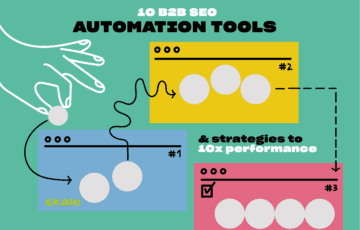
The Power of Partnership: 7 Benefits of Hiring a B2B SEO Agency
These benefits of hiring a B2B SEO agency illustrate why outsourcing your content can help you to drive new revenue for your business.

Search engine optimization is a critical component of any B2B acquisition strategy–if you’re here, that probably comes as no surprise.
However, more and more marketers need to understand how their SEO strategy is performing to know where crucial changes need to be made–and properly report to stakeholders.
SEO is much more than keyword research and organic traffic to your landing pages–but what exactly are B2B SEO benchmarks, and which ones should you be looking at to get the insights that you need?
Look no further, here we’ll go through a selected list of nine unmissable benchmarks and KPIs you need to track to make the most out of your SEO efforts.
First up, let’s check what B2B SEO benchmarks are and why they’re so important.
B2B SEO benchmarks are evaluative milestones that chart your B2B company’s SEO performance, situate efforts in relation to your competitors, and allow you to make adjustments to hit growth goals.
Keeping an eye on business benchmarks has long been second nature to all business owners, but SEO benchmarks are relatively new, certainly here to stay, and brimming with company growth potential.
Not all SEO benchmarks are created equal. To get the best results, use B2B-specific KPIs. There may be metrics common to both B2B and B2C performance tracking, namely website traffic and conversion rates, but B2B requires a different focus.
Vanity metrics with shiny numbers may appeal to company investment stakeholders, but they won’t do much to help company growth.
The metrics we’ve selected will help you gain actionable insights:
Let’s dive into these benchmarks that need to be on your B2B radar–so you’re on the search engine’s radar.
It’s important to note that these benchmarks are B2B-specific because of the particular demands of their client base.
First, B2B target customers have a business mindset. They know what they’re looking for and want to find out if your solution will integrate well into their company structure. This means you need to be meeting the more defined, data-driven needs of a business customer base – which isn’t all bad compared to the fickle desires of a consumer. At least you know what you’re working with.
Secondly, the sales process for B2C customers is much more straightforward, whereas the B2B sales cycle is much longer and more complex. Purchases tend to be more costly and there is usually more than one decision maker which makes target customers spend a longer time making decisions.
For B2B businesses this means concentrating on retaining customers as much as attracting new ones, or that you focus on brand exposure and product education. B2B companies need to show off their expertise, persuading multiple decision-makers, while B2C SEO strategy is usually focused more on single decision-makers. User intent must be the priority for B2B marketers looking to convert potential leads into paying customers.
So, now you know why it’s important to leverage a successful B2B-specific SEO strategy.
Now let’s find out how with our list of the ten most significant SEO benchmarks that actually matter to B2B businesses.
Website traffic KPIs are a great place to start. Unique visitors metric measures the number of people who visit your website over a set period of time. Rather than the total number of visits—often a vanity metric, this metric count individual (new) visitors.
This metric is useful for the notoriously longer B2B buyer cycle, as visitors are more likely to return to your website multiple times if they’re seriously considering investing.
Unique visitors is one of the most telling website KPIs, helping you more accurately gauge levels of interest and growth rates in new visitor numbers. The numbers will also give you a stronger picture of brand reach and SEO campaign success.
Many analytics tools, like Google Analytics, will also be able to tell you which visitors are coming through organic search results and which are coming through paid campaigns. This helps to optimize your marketing budget by indicating which campaigns are proving successful (paid or organic) and which could do with some TLC.
It’s useful benchmarking your number of unique visitors against the average in your industry sector to benchmark yourself against your competitors and work out areas of improvement. You can also benchmark unique visitors against your most successful signup months (considering your consideration backlog time) or against the same month in a previous year if you tend to operate on season sales.
CAC is calculated by dividing the total cost of product marketing and sales efforts by the total number of new customers. It’s a crucial KPI to understand the efficiency of your customer acquisition strategy, by indicating how costly — and how profitable — growth is for your business.
CAC is also a useful metric to show potential stakeholders, as it enables them to gauge the scalability of your business. It also demonstrates transparency from your end. In B2B SaaS, the average paid customer acquisition cost is $341, while the average organic CAC stands at $205.
LTV is the total worth to your business from a single customer contract during the total time they spend as a paying customer. As a metric it’s slightly more complex to calculate, depending on the measurements you have available.
It also depends on whether your core subscription metric is ARR or MRR. If you’re operating on annual subscriptions (yearly contracts) LTV may take longer to work out if you’re running it for the first time. However, if you’re operating on monthly subscriptions, you’ll have an idea of this quicker.
One of the main uses of LTV is calculating the LTV to CAC ratio. This ratio (LTV divided by CAC) informs you of the relationship between the lifetime value of a customer and the cost of acquiring that customer.
This KPI helps direct your marketing budget either towards customer acquisition or customer retention, saving time and money in product marketing efforts.
Ideally, you want to be aiming for an LTV to CAC ratio of at least 3:1.
SEO ROI (return on investment) is the ultimate measure of the financial success of your SEO performance.
It’s slightly different from the other KPI benchmarks we’ve explored, offering a more holistic evaluation. SEO ROI informs you of the overall profitability of your SEO strategy by comparing the amount of money invested with the total profit.
This is (put simply) calculated by the value of organic conversions minus the cost of SEO investments, divided by the total cost of SEO investments.
As with any business, developing a stellar marketing budget for your B2B company is half the battle. You can have the best B2B marketing plan out there, but that won’t mean anything if you don’t have the funds to implement it.
Determining SEO ROI is a useful way to keep tabs on your profits, and continually readjust your marketing plan accordingly. You want to be aiming for an average SEO ROI of 5:1, or 500%.
CTA: Download the SEO ROI Free Tracker here.
Pretty much what it says on the tin, click-through rate is simply the number of clicks your digital marketing campaign (whether paid search, email, or social media campaign) has received, divided by the number of total impressions. High CTRs mean more successful (profitable) online campaigns.
When it comes to search engine results pages (SERPs), in addition to indicating the success of paid ads, click-through rate can also measure the effectiveness of organic searches. Organic searches send 53% of all traffic to websites, so they’re a really significant source of visitors—and potential buyers.
CTR compares the number of impressions with the number of people who actually click on the link. So, if 1000 people see your website on a SERP listing, and 50 clicks through to your site, your CTR would be 5%.
In terms of what to aim for, it really depends on the type of campaign, as it can vary wildly. However, in general, a good SERP click-through rate for B2B businesses is about 2.5%. When starting out, most B2B businesses will have a CTR of around 1%, but this should increase over time.
CTRs also vary by industry; while travel and real estate tend to have higher click-through rates, financial services, home improvement, and legal services typically have lower rates.
Session duration refers to the length of time visitors are spending on your website. By default, it also helps to measure your website’s user engagement levels. Is your content drawing visitors in? Is your website easy to navigate? Are you successfully attracting your target market and retaining them on-site?
Since a core goal of a B2B website is to present the company as a source of expertise, it’s essential to aim for good session duration figures. The longer a user stays on your website and the more resources they benefit from, the bigger your chance of converting them to a paying customer.
As with all KPI metrics, average session duration benchmarks vary from sector to sector. For example, Fintech B2B websites have an average session duration of 3:28 minutes, while B2B SaaS is around 4:26 minutes. If you have a blog, whatever the industry, you’ll want to benchmark the read time of each piece: too short or too long could mean your readers (and potential customers) are having a negative experience. Make sure you do your homework so that you’re accurately benchmarking your scores.
A marketing qualified lead (MQL) is a website visitor that becomes a lead when they are successfully reviewed by the marketing team and satisfy specific criteria to qualify as a potential customer. Monitoring this conversion rate is important because the transition from lead to MQL is considered the first important step in the marketing process.
It’s also significant because not even half of leads generated by B2B marketing teams are qualified to buy their company’s products, meaning that many companies are wasting precious time and resources on pointless lead generation. Tracking the lead-to-MQL conversion rate can therefore help refine marketing efforts and direct sales efforts to leads that match the target customer profile.
To work out your MQL conversion rate, you’ll need to divide MQLs by the total number of leads generated over a certain period of time. If your B2B business is generating, let’s say, 1000 leads every month, and 200 of those are MQLs, your conversion rate would be 20%.
You’re probably wondering how many MQLs you’re looking to attract. Well, there’s good news and bad news. Bad news first: there’s no simple target metric that will fit all B2B businesses. The good news, however, is that it’s fairly simple to work out.
Once you’ve got your MQLs under control, you should be tracking and monitoring these leads as they make their way through the sales funnel and become SQLs, or sales-qualified leads.
SQLs are those who are showing real buyer intent, verified as potential customers by your sales team. Keeping track of lead development is vital to helping marketing and sales teams foster leads all the way down the sales pipeline to making a purchase.
To calculate this metric, you’ll need to divide your number of SQLs by your MQLs. If 35 of your 200 MQLs become SQLs, your conversion rate will be 37.5%.
While dependent on industry and company size as ever, B2B businesses tracking their MQL-to-SQL rate should aim for around 31% for website leads and 24% for customer/employee referrals.
MRR is a straightforward, normalized measure of how much revenue your B2B company can expect to receive each month. It’s based on the number of customers you have, and how much you receive from them every month.
Monitoring this metric will reveal the state of your business revenue—whether it’s generally increasing or decreasing. This is particularly important for SaaS businesses or any companies that rely on subscription-based customers.
Calculating this metric couldn’t be easier. All you need to do is multiply your average revenue per account by the total number of customers for that specific month. For example, if you have 500 customers paying an average of $20 every month, your MRR would be $10,000.
This benchmark is vital for all subscription-based B2B companies. Tracking MRR can help you identify the factors which have the most influence on your average revenue, particularly as you can divide your MRR into three categories:
The insight gained from these can be a game changer for investment pitches, and provides incredibly useful context for marketing campaigns, product reception, and brand recognition.
As the name would suggest, your monthly recurring revenue will change every month, corresponding to any revenue gained or lost, so your target MRR will be entirely specific to your company and your revenue goals.
A B2B company’s churn rate refers to the percentage of subscribers or contractual customers who cancel their subscriptions over a specific period of time—usually over the course of a month or a year. Like MRR, it’s particularly important for B2B SaaS companies that require repeated monthly payments from their customers.
Churn rate can be used to determine the revenue lost from lost (or ‘churned’) customers, as well as determining the efficacy of customer retention strategies, customer satisfaction, and product growth.
To calculate customer churn, you simply need to divide the number of churned customers by the total number of customers. For example, if your B2B business has a total of 1000 customers, and you lose 70 in a month, your customer churn rate for that month will be 7%.
You can use this metric to find out your net logo churn—which takes into account the number of customers gained over a given period—by dividing the total number of churned customers minus the new customers acquired by the total number of customers. Using the same example, let’s say that in addition to losing those 70 customers, you also gained 20. In this case, your net logo churn would be 5%.
Another option is the revenue churn rate, which indicates the percentage of lost revenue due to canceled subscriptions, downgrades, or other factors. To calculate revenue churn, you simply need to divide the total churned revenue over a specific period of time by the total revenue at the start of that period. Let’s say your total business revenue is $10,000. If your churned revenue over the course of one month is $200, your revenue churn rate for that month would be 2%.
For subscription-based businesses, churn rate is probably the most significant benchmark metric. While churn rates will vary widely, depending on factors such as industry and company size, an average B2B churn rate should be 5% or under, and logo churn between 3-7% for smaller, younger businesses and 1-2% for larger businesses.
Ultimately, developing a strong SEO strategy is a surefire way to turn those potential customers looking for the solution you can provide into paying customers.
Taking the time to improve and measure performance is your most effective tactic in ensuring a strong SEO strategy.
An SEO strategy is never concrete—for best results, you need to be adjusting it in line with your B2B SEO benchmarks.
These metrics not only help you compare your company against competitors, but also determine the success of your SEO campaigns: which ones are paying off, which ones need to be tweaked, and which can be kicked to the curb.
Hiring a B2B SEO agency such as Skale can give you expert advice, keep you up to date with SEO trends, and get you started in your journey to becoming a B2B SEO boss. The first step is understanding where your business SEO is at, and what you need to improve on — and now you know how! Right?
B2B SEO (search engine optimization) benchmarks are evaluative milestones that chart your B2B company’s SEO performance, compare it in relation to your competitors and enable you to make adjustments accordingly. They’re vital to maintaining an efficient SEO strategy and they’re essential for company growth. Priority B2B benchmarks include unique visitors, average session duration, customer acquisition cost, and SEO ROI.
SEO benchmarks are important for B2B websites because customers tend to spend longer on these websites. In addition to the longer buying cycle, B2B customers normally come equipped with data-driven needs and a business mindset that knows exactly what they’re looking for. B2B company websites must come across as an authority in the industry, with fast-loading, professional website design, and relevant, engaging content.
A strong SEO strategy can prove extremely effective for B2B companies, as one of the most important customer acquisition channels for B2B businesses. Streamline your website and ensure your content is as informative and reliable to ensure you’re optimizing your chances of SEO-generated leads
Learn more about
B2B SEO

The Power of Partnership: 7 Benefits of Hiring a B2B SEO Agency
These benefits of hiring a B2B SEO agency illustrate why outsourcing your content can help you to drive new revenue for your business.

15 B2B Customer Acquisition Strategies that Increase Revenue
Want to find new customers who truly value your business? We’re here to help you out with a list of the top 15 B2B customer acquisition strategies.

10 B2B SEO Automation Tools & Strategies to 10x Performance in 2024
Save time with the right B2B SEO automation tools and strategies that are sure to bring your marketing to the next level–we've listed them here.